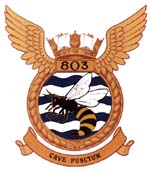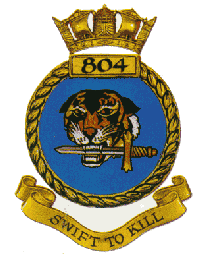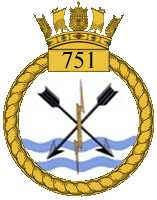
The Supermarine Scimitar is a single-seat naval strike aircraft that was designed and produced by the British aircraft manufacturer Supermarine. Operated exclusively by the Royal Navy's Fleet Air Arm, it was the final aircraft to be entirely designed and manufactured by Supermarine.

800 Naval Air Squadron was a Royal Navy Fleet Air Arm carrier-based squadron formed on 3 April 1933 by amalgamating No's 402 and 404 Flights.
801 Naval Air Squadron (NAS) was a Fleet Air Arm squadron of the Royal Navy formed in 1933 which fought in World War II, the Korean War and the Falklands War.

803 Naval Air Squadron was a Fleet Air Arm (FAA) naval air squadron of the United Kingdom's Royal Navy (RN). The squadron was operational on four occasions from 1933 to 1946, subsequently transitioning to a Royal Canadian Navy squadron from 1946 to 1951. It had an additional four separate periods of activity within the Royal Navy from 1951 to 1969.

809 Naval Air Squadron, nicknamed the Immortals, is a squadron of the Fleet Air Arm of the United Kingdom. It was first formed in 1941 and flew in the Soviet Union, the Mediterranean and the Far East during the Second World War. After active service during the Suez Crisis, 809 was disbanded in 1959. Reformed in 1963 to fly Blackburn Buccaneers, the squadron was disbanded briefly in 1965–66, and then again in 1978. A brief period during the Falklands War saw 809 reformed to bring Sea Harrier FRS.1 aircraft south to the UK task group and to fly from HMS Illustrious.

804 Naval Air Squadron was a Fleet Air Arm (FAA) naval air squadron of the United Kingdom’s Royal Navy (RN), formed in November 1939 from part of 769 NAS Sea Gladiators which had been detached to RNAS Hatston. The squadron was merged into 800 NAS in June 1944 and subsequently reformed in September.
810 Naval Air Squadron was a Royal Navy Fleet Air Arm carrier based squadron formed on 3 April 1933 with the amalgamation of the 12 Blackburn Dart aircraft from 463 and 44 Flight Flights Royal Air Force to the Fleet Air Arm. The squadron saw action during the Second World War, the Suez Crisis and the Korean War.

808 Naval Air Squadron is a ship-based helicopter squadron of the Royal Australian Navy.

736 Naval Air Squadron was a Fleet Air Arm (FAA) naval air squadron of the United Kingdom’s Royal Navy (RN). It was most recently recommissioned at HMS Seahawk, RNAS Culdrose in June 2013 to fly the BAE Systems Hawk, mainly in the maritime aggressor role, following the disbandment of the Fleet Requirements and Aircraft Direction Unit (FRADU) and operated up until March 2022. It initially formed as the School of Air Combat in May 1943 at HMS Heron, RNAS Yeovilton. In September 1943 it moved to HMS Vulture, RNAS St Merryn, where it became the Fighter Combat School and it created an independent 'B' Flight for fighter affiliation work between March and September 1945. 736 Naval Air Squadron moved to HMS Seahawk, RNAS Culdrose in February 1950 as the Naval Air Fighter School in the 52nd Training Air Group, but disbanded in August 1952. Immediately the following day, the squadron reformed at HMS Seahawk, RNAS Culdrose out of 702 Naval Air Squadron as an Advanced Jet Flying School and in November 1953 it moved to HMS Fulmar, RNAS Lossiemouth. 736 Naval Air Squadron disbanded there in March 1965, but what was left became 764 Naval Air Squadron ‘B’ Flight. The squadron reformed the same day at Lossiemouth from 809 Naval Air Squadron as a Jet Strike Training Squadron. 1966. In March 1967, its aircraft were part of the group that bombed and set on fire the supertanker SS Torrey Canyon aground and leaking crude oil on Seven Sisters rocks off Cornwall. The squadron disbanded in February 1972.

891 Naval Air Squadron was a Fleet Air Arm (FAA) naval air squadron of the United Kingdom’s Royal Navy (RN). In August 1942 the squadron transferred from RNAS Lee-on-Solent where it had been formed in July to RNAS Charlton Horethorne with Hawker Sea Hurricane aircraft to prepare for carrier operations, later transferring to RNAS St Merryn and then embarking on HMS Dasher to take part in Operation Torch. The squadron was disbanded in April 1943, but was reformed in June 1945 and equipped with Hellcat in order to operate in the Pacific, but the war ended before they could be deployed. The squadron was disbanded in September 1945.
802 Naval Air Squadron was a Naval Air Squadron of the Royal Navy's Fleet Air Arm.

899 Naval Air Squadron was a squadron of the Fleet Air Arm of the United Kingdom.

879 Naval Air Squadron was a Naval Air Squadron of the Royal Navy's Fleet Air Arm that was active during the Second World War. It was formed in 1942, and from 1943 was equipped with Supermarine Seafire fighters, operating mainly in the Mediterranean Sea. It took part in the Allied landings at Salerno, Italy in 1943 and Operation Dragoon, the Allied invasion of southern France. It was disbanded in 1946.

890 Naval Air Squadron was a Fleet Air Arm (FAA) naval air squadron of the United Kingdom’s Royal Navy (RN). The squadron was formed in June 1942 in Nova Scotia as a fighter unit and did not receive aircraft until it reached Norfolk, Virginia, in June. There, it obtained ex-USN F4F-3 Wildcats and later exchanged for Grumman Martlet Mk IV before boarding HMS Battler on December 8 for a trip to the UK, arriving in January 1943. After incorporating 'A' Flight from 881 Naval Air Squadron, it joined HMS Illustrious in June for operations in Iceland and Norway, later supporting the Salerno landings in September 1943, before disbanding in Puttalam, Ceylon, in August 1944.

895 Naval Air Squadron was a Fleet Air Arm (FAA) naval air squadron of the United Kingdom’s Royal Navy (RN). It was established at HMS Blackcap, RNAS Stretton, as a fighter squadron in November 1942. It started with Hawker Sea Hurricane, which were later changed to Supermarine Seafire. The squadron was disbanded at RAF Turnhouse in June 1943, and provided fighter flights for 816 and 842 Naval Air Squadrons.

738 Naval Air Squadron was a Fleet Air Arm (FAA) naval air squadron of the United Kingdom’s Royal Navy (RN), which last disbanded during May 1970 at HMS Goldcrest, RNAS Brawdy. It initially formed as a Pilot Training Squadron formed at HMS Asbury, RNAS Quonset Point, Rhode Island, in February 1943. The squadron moved to RNAS Lewiston, Maine, United States, at the end of July 1943 and also providing advanced carrier training to American-trained Royal Naval Volunteer Reserve (RNVR) pilots and it later provided complete Torpedo Bomber Reconnaissance (TBR) aircrew for Grumman Avenger FAA squadrons. The squadron moved to RNAS Brunswick, Maine, in February 1945 and disbanded there in July 1945. 738 Naval Air Squadron was next active as part of the Naval Air Fighter School, between May 1950 and March 1954, providing newly qualified FAA pilots the operational techniques of air-to-air and air-to-ground firing. It had formed at HMS Seahawk, RNAS Culdrose, Cornwall, England, moving to HMS Fulmar, RNAS Lossiemouth in 1953. It reformed in April 1954 at HMS Fulmar and now the squadron’s role was to instruct United States trained pilots on the British method and was also responsible for converting the FAA piston-engined pilots onto jet aircraft. It became an Advanced Flying Training Squadron in June 1962 providing training for low-level navigation, ground attack and air-to-air weapons training.

751 Naval Air Squadron was a Fleet Air Arm (FAA) naval air squadron of the United Kingdom’s Royal Navy (RN). It was initially active as an Observer Training Squadron from 1939 to 1944 as part of No.1 Observer School. 751 Naval Air Squadron formed at RNAS Ford in May 1939. Ford was attacked and bombed, in August 1940, and the following day the squadron relocated to RNAS Arbroath. Twelve months later it moved to RNAS Dundee, remaining there until disbanding at Dundee in May 1944.

764 Naval Air Squadron was a Fleet Air Arm (FAA) naval air squadron of the United Kingdom’s Royal Navy (RN). It initially formed in April 1940, at HMS Daedalus, RNAS Lee-on-Solent, as an Advance Seaplane Training Squadron. The Squadron moved to RAF Pembroke Dock in July 1940, and later to HMS Daedalus II, RNAS Lawrenny Ferry in October 1941 and remaining there until the Squadron disbanded in November 1943. It reformed at HMS Siskin, RNAS Gosport, in February 1944, as the User Trials Unit, however, the squadron was decommissioned for the second time in September 1945. 764 Naval Air Squadron reformed again, at HMS Fulmar, RNAS Lossiemouth, in May 1953, where it became an Advanced Training Unit. It moved to HMS Heron, RNAS Yeovilton, in September 1953, where it received its first jet aircraft. In November 1954 the Squadron disbanded.

Royal Naval Air Station Twatt, is a former military airfield, located near Twatt, Orkney, Scotland, of the Royal Navy. It was built by the Admiralty and was commissioned on 1 April 1941. On 1 January 1942 it became an independent command as HMS Tern. The airbase was designed to provide accommodation for disembarked Front-Line squadrons and accommodation for disembarked Ship's Flight Aircraft and was home to the Home Fleet Fleet Requirements Unit, 771 Naval Air Squadron.
















